|
Athletes
with vision impairment
The
swimmers with vision impairment are classified into
three classes, according to the degree of their vision
loss. The classes are: S11-SB11-SM11, S12-SB12-SM12 and
S13-SB13-SM13. The classes starting with an S are
for freestyle, backstroke and butterfly, the classes SB
are for breaststroke and the classes SM for individual
medley. The events included are:

|

|
50m,
100m and 400m freestyle
|
|

|
100m
backstroke
|
|

|
100m
breaststroke
|
|

|
100m
butterfly
|
|

|
200m
individual medley
|
|

|
4x100m
freestyle relay and 4x100m medley relay
|
During
a Swimming event, every athlete with total vision loss
has an assistant to help him as he or she approaches the
swimming pool end wall, either to make a turn or for the
finish of the race. The assistant, using a pole at the
end of which is attached a soft object, touches the
swimmer on the head or shoulder as a warning that he or
she is approaching the pool end wall.
Athletes
with a physical disability
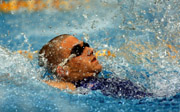 In
the case of swimmers with a physical disability,
classification is based on several factors. In
the case of swimmers with a physical disability,
classification is based on several factors.
Functional ability is assessed first, which includes the
degree of muscle strength, movement coordination, limb
length or the scope of the athlete's limb range of
movement, based on the type of disability. The
functional ability and the limitation of the athlete’s
movements in the water are then assessed in the various
swimming styles.
After
the assessment is completed, athletes are classified as
follows:
|

|
10
classes, S1-S10, in freestyle, backstroke and
butterfly,
|
|

|
8 classes,
SB2-SB9, for breaststroke and
|
|

|
8 classes,
SM3-SM10, for individual medley.
|
According
to this classification system, athletes with similar or
like locomotor abilities are classified in the same
category, regardless of the type of disability. The
greater the potential of an athlete, the higher the
category in which he or she will be classified.
Furthermore, an athlete can be classified in one
category for a certain swimming style and in a different
category for another. For example, he or she can compete
in category S5 in freestyle, SB4 in breaststroke and SM5
in the individual medley.
Depending
on the categories in which each athlete with a physical
disability is classified, he or she can participate in
one or more of the following events:
|

|
50m
and 100m freestyle: class S1 men only and S2 to
S10
|
|

|
200m
freestyle: class S2 men only and S3 to S5
|
|

|
400m
freestyle: class S6 to S10
|
|

|
50m
backstroke: class S1 men only and S2 to S5
|
|

|
100m
backstroke: class S6 to S10
|
|

|
50m
butterfly: class S4 to S7
|
|

|
100m
butterfly: class S8 to S10
|
|

|
50m
breaststroke: class SB2 men only and SB3
|
|

|
100m
breaststroke: class SB4 to SB9
|
|

|
150m
individual medley: class SM3 men only and
SM4
|
|

|
200m
individual medley: class SM5 men only and SM6 to
SM10
|
|

|
Relay
4x50m freestyle and 4x50 medley relay
|
|

|
Relay
4x100m freestyle and 4x100m medley relay
|
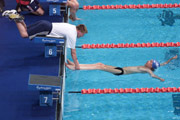 Swimmers
who, due to functional limitations, cannot make a start
from the starting platform, have the right to start from
inside the water. At the start, an assistant is allowed
to hold certain identified swimmers by the feet, the
legs, the hands or arms at the swimming pool
end wall, but assistants are not permitted to give
the athlete any impetus. Swimmers
who, due to functional limitations, cannot make a start
from the starting platform, have the right to start from
inside the water. At the start, an assistant is allowed
to hold certain identified swimmers by the feet, the
legs, the hands or arms at the swimming pool
end wall, but assistants are not permitted to give
the athlete any impetus.
Also
see:  
|







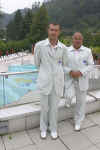


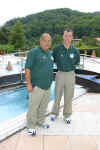
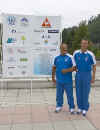




 In
the case of swimmers with a physical disability,
classification is based on several factors.
In
the case of swimmers with a physical disability,
classification is based on several factors. Swimmers
who, due to functional limitations, cannot make a start
from the starting platform, have the right to start from
inside the water. At the start, an assistant is allowed
to hold certain identified swimmers by the feet, the
legs, the hands or arms at the swimming pool
end wall, but assistants are not permitted to give
the athlete any impetus.
Swimmers
who, due to functional limitations, cannot make a start
from the starting platform, have the right to start from
inside the water. At the start, an assistant is allowed
to hold certain identified swimmers by the feet, the
legs, the hands or arms at the swimming pool
end wall, but assistants are not permitted to give
the athlete any impetus.



